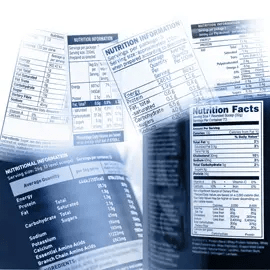Reading Food Labels
 What should I eat?
What should I eat?
This question has so many potential answers that it can be overwhelming to find the right one. Fortunately, there’s a tool that can help us make more informed eating decisions: the nutrition label.
Nutrition labels can tell us exactly what’s in our food before we eat it. If you know how to read nutrition labels, they can help you stick with a nutritious diet during your weight loss program and beyond.
Nutrition labels can make it easier to:
- Eat healthy portion sizes
- Cut calories, carbohydrates and unhealthy fats from your diet
- Eat more essential nutrients
Making Sense of the Nutrition Label
From top to bottom, here are the sections of the nutrition label and how to use them to your advantage:
Serving Size
Because it tells you how much you’ll need to eat to get the calories and nutrients listed below, the serving size is your guide to the rest of the label. Just be sure to check out both the serving size and the number of servings per container—you should never assume that a whole package is a single serving.
Calories
You can use the number of total calories to compare different foods and choose low-calorie options. In this section, you’ll also find information on calories from fat, which can help you quickly find foods that are lower in overall fat content.
Nutritional Value
The rest of the nutrition label is devoted to the many different nutrients each food contains, like fat, sodium, carbohydrates, protein and fiber. Each nutrient is listed by grams or milligrams, while some are also listed by percent daily value (sometimes abbreviated as % DV).
Percent daily value is a general recommendation for the amount of each nutrient in a 2,000-calorie diet. If the label says a food contains 20 percent vitamin C, this means that one serving will provide 20 percent of the vitamin C most people need in one day.
Percent daily value may not apply directly to your diet, especially during medical weight loss, but it can still tell you if a food is a good or poor source of certain nutrients.
- If a food has 20 percent or more of a nutrient, it’s high in that nutrient.
- If a food has five percent or less of a nutrient, it’s low in that nutrient.
By using percent daily value and comparing the nutritional value of different foods, you can find better options for your diet. In general, you should look for foods that are low in:
- Total fat
- Saturated fat
- Cholesterol
- Sodium
- Carbohydrates
- Sugar
You should also try to find foods that are higher in:
- Protein
- Dietary fiber
- Vitamin A
- Vitamin C
- Calcium
- Iron
Many people look right past nutrition labels, but paying more attention to them can help you keep your food choices as healthy as possible. With a better understanding of the information a nutrition label provides, you can maintain a balanced diet during your weight loss program and the rest of your life.
